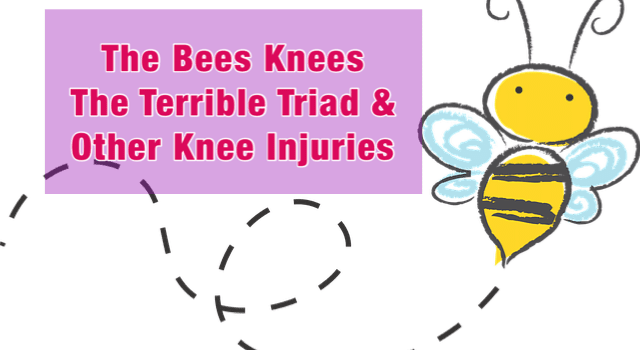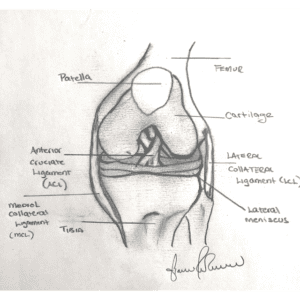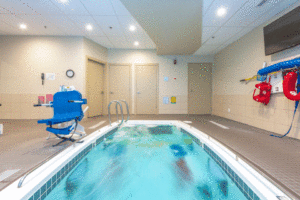
The Bees Knees, The Terrible Triad and Other Knee Injuries
Guest Post ~ Colin James
Nobody can really explain where the term “bees knees” came from. There isn’t anything overly impressive about bees knee – but your knees on the other hand are impressive. Your knees can be a lovely joint when they are working well. They play a massive role in getting us moving in ways that allow us to dance, climb, crawl, run, and bend. Unfortunately, it’s not uncommon for our knees to hamper us from doing the things that we love. Fortunately, treating knee pain (among other things) is something that we do every day. So let’s talk about why they sometimes work in ways that we don’t want them to, and how we can get them working in a way that let’s us move without issues.
Anatomy of the Knee
Below is a picture of the knee, with the knee cap removed. With the patella gone, we are able to see all of the internal workings of the knee that allow it to function properly. There are four primary ligaments in the knee: The medial (inside) collateral ligament, the lateral (outside) collateral ligament, as well as the anterior and posterior cruciate ligaments. These ligaments play a large role in providing stability for the knee. There are also two shock absorbing surfaces that comprise your meniscus. The medial (inside) and lateral (outside) menisci. The menisci sit between your tibia and your femur, and help to ensure smooth, congruent movement when bending, straightening, and twisting your knee.
Some of the more common injuries that we will see involve injuries to a few of the structures pictured above. ACL injuries, meniscal injuries, and osteoarthritis are all too common as far as injuries that individuals are often afflicted with. The good news is that we know what we need to do to fix them, we have the tools to help us do so, and there is an extensive body of research supporting the use of rehabilitation in the effective treatment of these issues! Frasen et. al (2015) found that therapeutic exercise in the treatment of osteoarthritic knee pain, when administered in appropriate doses, can result in reduced pain and improved quality of life. They also note that the benefit for pain is comparable with to the use of current simple analgesics and non-steroidal anti-inflammatory drugs taken for knee pain.
The Terrible Triad Doesn’t Have To Be So Terrible
One of the more serious injuries that we will see in clinic involves the simultaneous injury of some of the structures previously mentioned, and is dubbed ominously as “the terrible triad”. As scary as it sounds, it is named as such only because it involves three separate structure that love getting injured alongside one another: the 1) ACL (Anterior Cruciate Ligament), 2) medial meniscus, and 3) MCL (Medial Collateral Ligament). We all know a soccer player or other athlete that has injured either one or all of these parts of the knee. The not-so-terrible news is that these injuries tend to respond positively to physical therapy and rehabilitation, and that research supports this! For example, Ericsson et. Al (2009) found that “functional exercise training was well tolerated and improved functional performance…in middle?aged subjects with a previous degenerative meniscal injury and partial meniscectomy”
After we’ve worked on restoring full range of motion at the knee, a major priority for our rehabilitative process is to progressively strengthen the knee and its surrounding musculature. During this process, we want to progressively work towards having the knee, and the individual, tolerate higher loads, and higher-level activities. The proper type, and the proper amount of movement can help to ensure a safe and confident return to activity, whatever it may be. Whether its walking (or jogging) during a shopping spree, getting in and out of the car, walking on ice, beer-league hockey, or gearing up for a return to sport, restoring quadricep, gluteal, hamstring and calf strength is critical in making sure you’re 100% ready.
Should I Have Surgery, or Should I Try Rehab?
What is important to remember, is that there is no hard and fast rule for any individuals particular course of rehab, and therefore no easy or straight forward answer to the question of whether or not surgery for your knee pain / injury is necessary. The answer will depend on, and should include consideration of: the type and severity of the injury, the symptoms you are dealing with and how they are impacting your function, age, and what your goals are as far as what activities you are looking to return to. Whatever the thought process, it is important to remember that surgery is not always the answer, and that physical therapy can often postpone or prevent the need for an operation. In the case of degenerative knee pathology, for example, the British Medical Journal released guidelines for management. Part of the guidelines recommend strongly against the use of arthroscopic knee surgery for patients dealing with knee pain related to degeneration. In part, these recommendations were based on findings that note the risks associated with surgery, and that the benefits to these surgeries are not superior to exercise therapy in the long term. From research like this, programs aimed at education, fitness and strengthening have been developed. An example is GLA:D Canada which we proudly offer at our St. Albert location.
So What Can We Do About It?
Although we can’t all be Connor Mcdavid (he has youth, training and genetics that unfortunately we can’t be all graced with), our facilities, clinicians, and technology help to mimic the pro-athlete rehab experience. His injury and rehabilitative process serve as a testament to the fact that surgery isn’t always the best choice of treatment, and with the proper programming and supervision, one can safely return to a high level of function without having to go under the knife. At Leading Edge, patients are given access to state-of-the-art equipment and programming that help in providing you the same care that a pro-athlete would expect – surgery or not. Whether it’s a work-out in the swimex hydrotherapy pool, a run on the AlterG anti-gravity treadmill, or a recovery session on the Normatec compression sleeves, we can help to facilitate the rehabilitative process needed to get you back to your normal. So don’t let these injuries give you the bees knees, whatever that means.
https://www.ncbi.nlm.nih.gov/pubmed/26405113 (Fransen et. Al, 2015)
https://onlinelibrary.wiley.com/doi/full/10.1111/j.1600-0838.2008.00794.x (Ericsson et. Al 2009)


